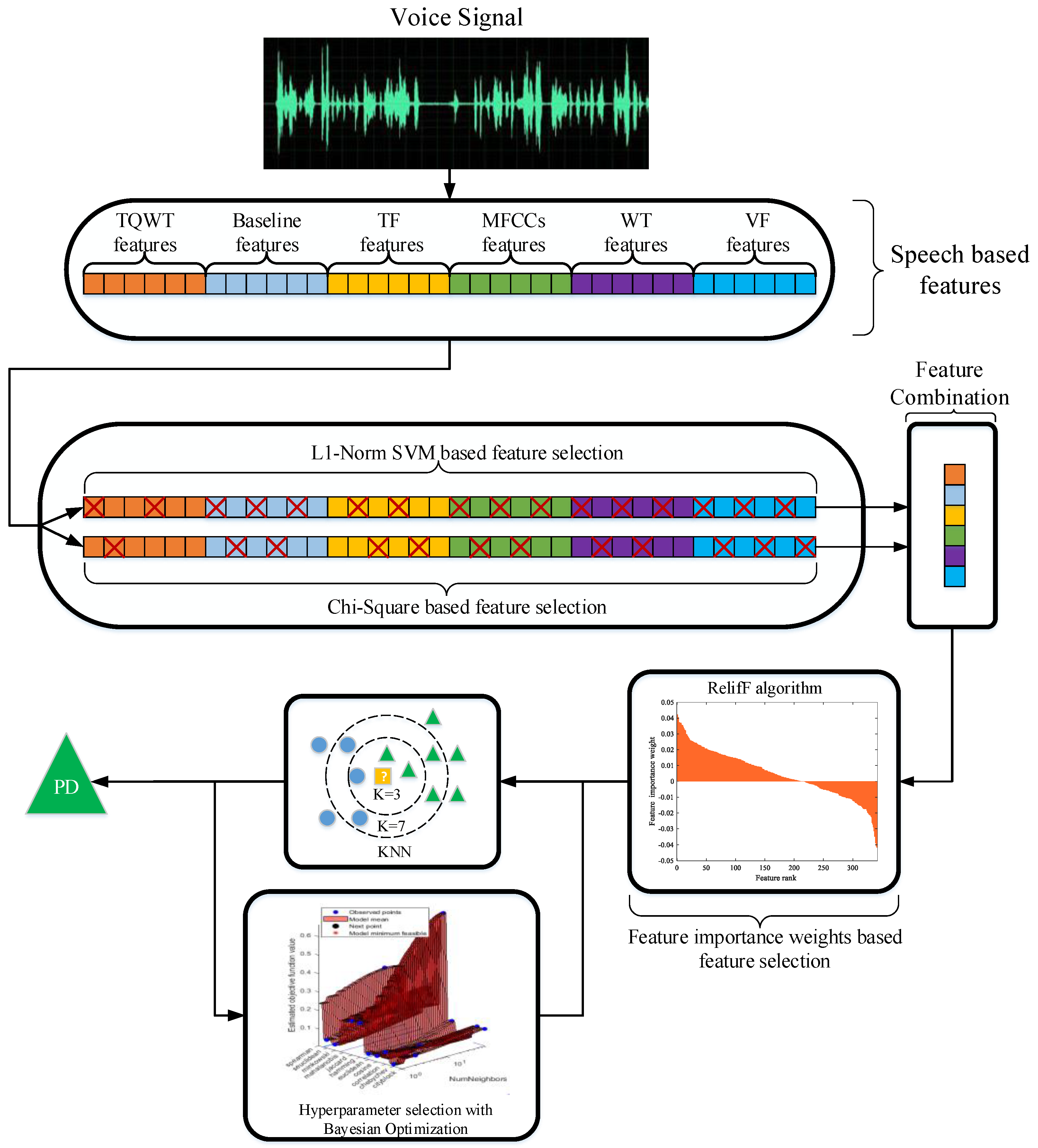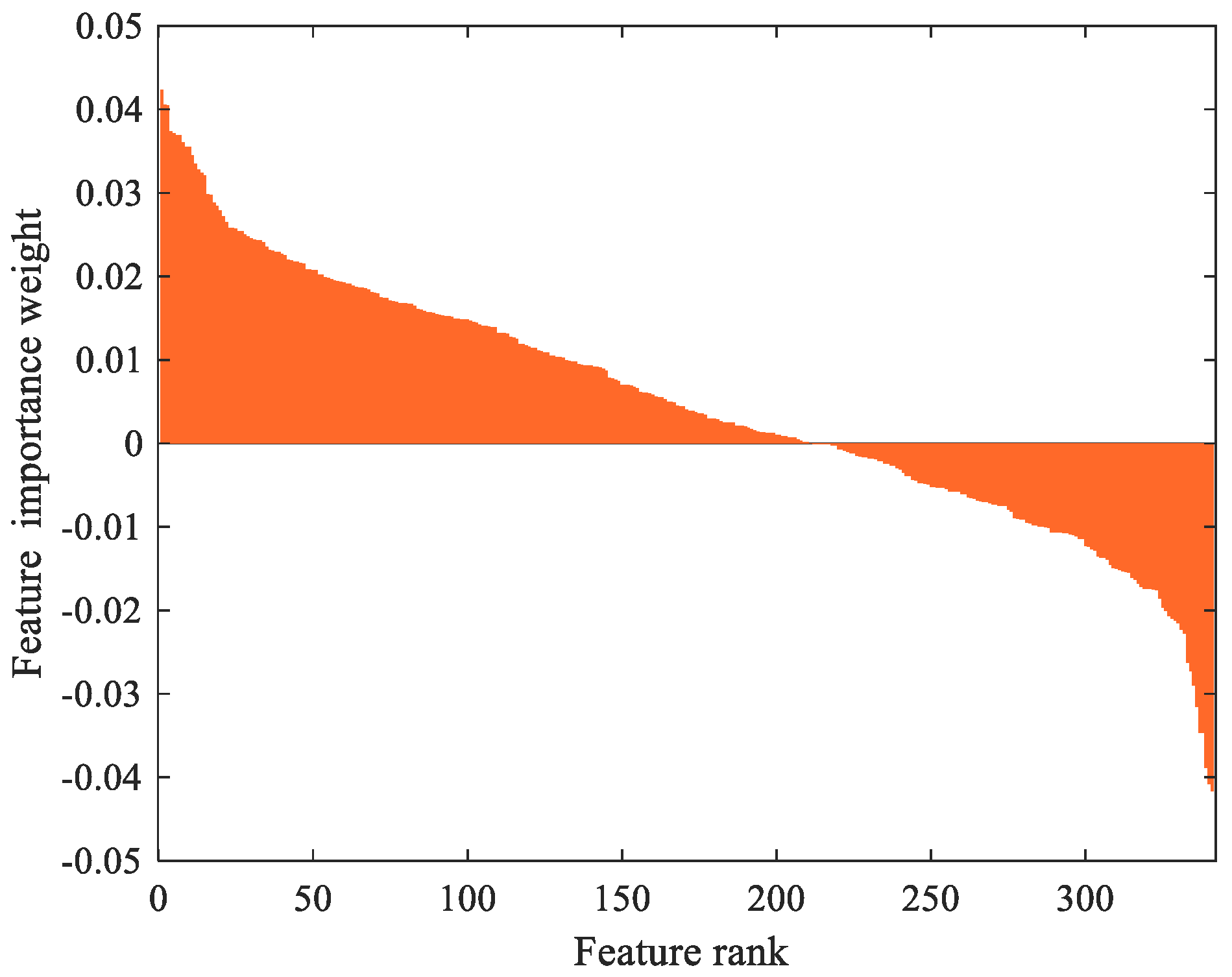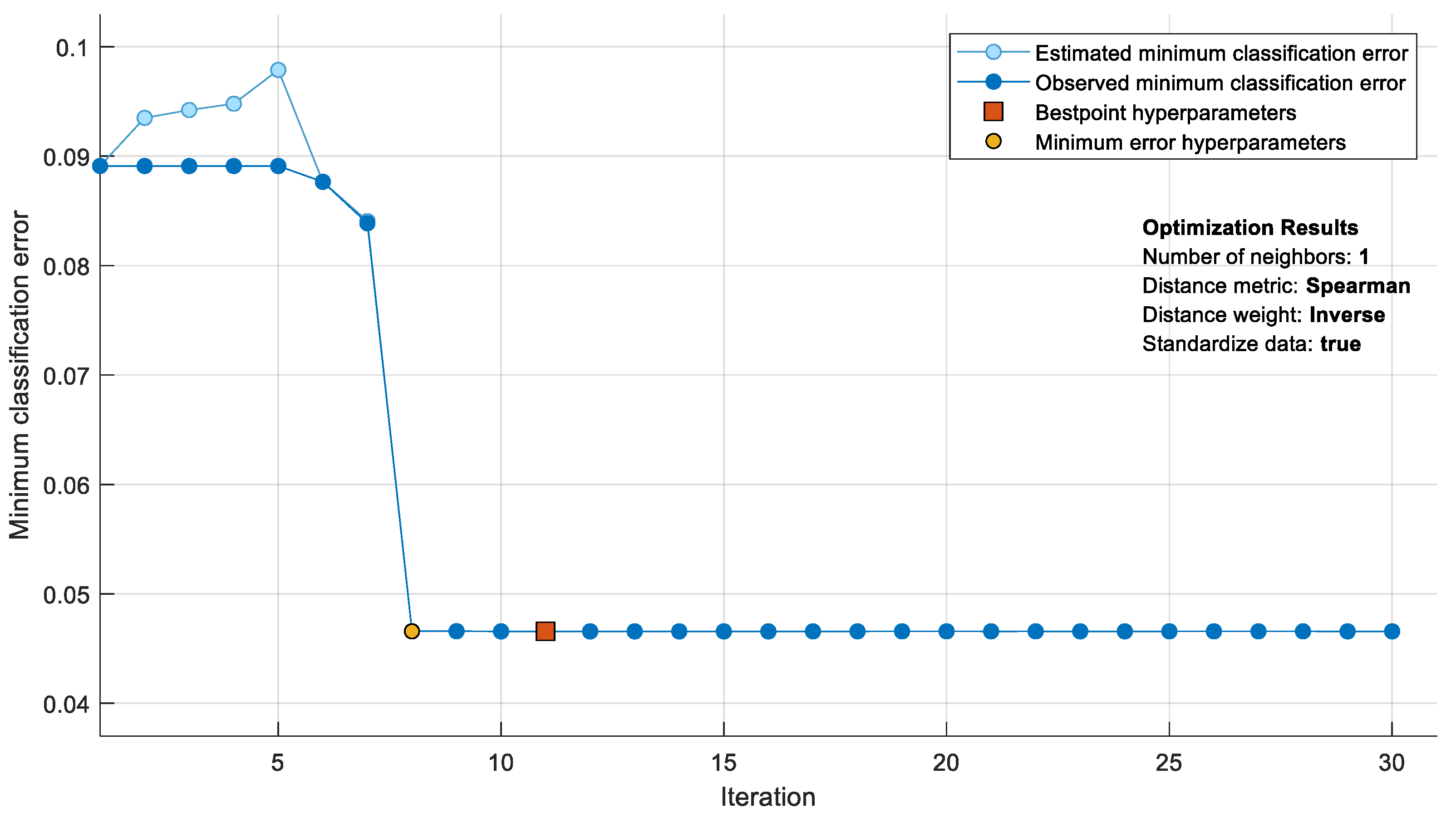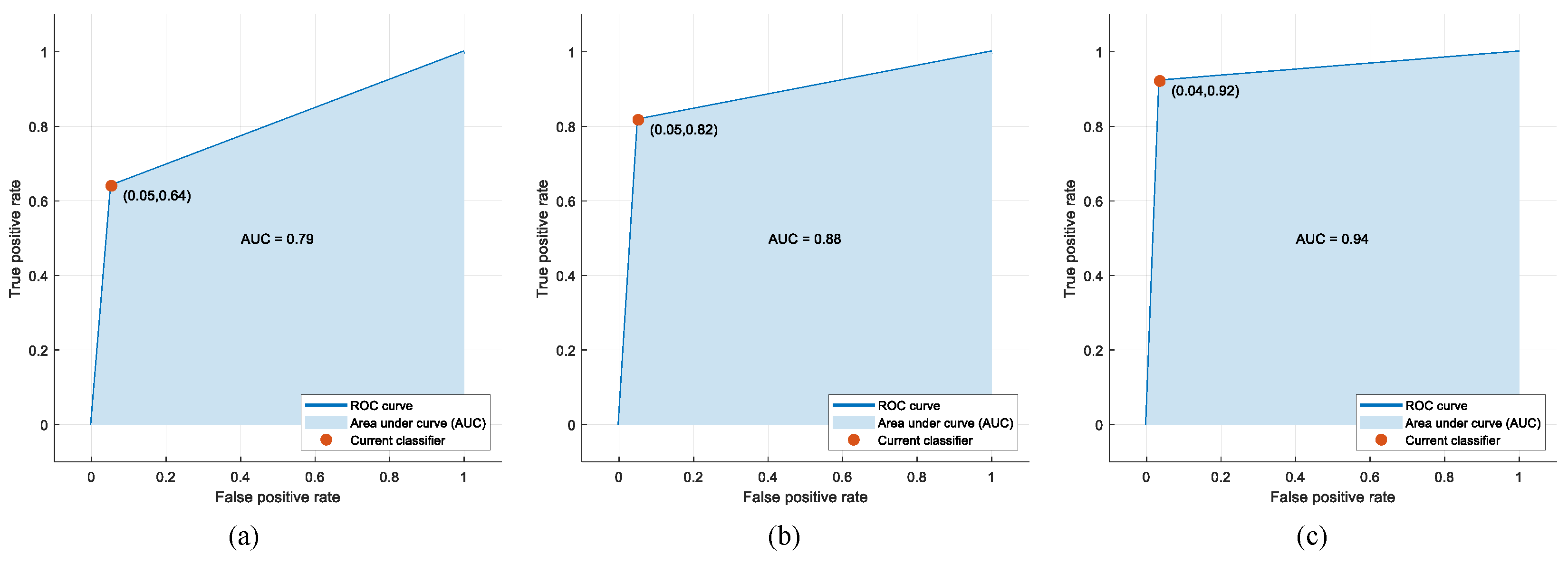A Simple and Effective Approach Based on a Multi-Level Feature Selection for Automated Parkinson’s Disease Detection
Abstract
:1. Introduction
- −
- Compared to popular deep learning models, the computational cost of the proposed approach is very low. Therefore, the proposed approach can be applied in clinical practice with low-capacity hardware.
- −
- By using CLS feature selection, higher performance was achieved with fewer features.
- −
- Due to the small number of iterations, the hyperparameters that achieved the best performance in the KNN classifier were found with the Bayesian algorithm.
2. Literature Work
3. Dataset
4. Methodology and Machine Learning Techniques
4.1. Methodology
- Step 1: Load features.
- Step 2: Adaptively create the first feature set according to classification error with the Chi-square algorithm.
- Step 3: Constitute the second feature set according to the punishment parameter (C) with the L1-Norm SVM algorithm.
- Step 4: Concatenate each two feature sets.
- Step 5: Compute the feature importance weights using the ReliefF algorithm.
- Step 6: Remove negative weights in the calculated weights from the concatenated feature set.
4.2. Multi-Level Feature Selection
4.3. L1-Norm SVM Algorithm
4.4. Chi-Square Algorithm
4.5. ReliefF Algorithm
4.6. KNN Classifier
4.7. Bayesian Optimization
- −
- Find by optimizing the utility function with a specific iteration→
- −
- Examine the objective function →
- −
- Put new values and update the data →
5. Experimental Studies
6. Discussion
7. Conclusions
Author Contributions
Funding
Institutional Review Board Statement
Informed Consent Statement
Data Availability Statement
Conflicts of Interest
References
- Duffy, J.R. Motor Speech Disorders E-Book: Substrates, Differential Diagnosis, and Management; Elsevier Health Sciences: Amsterdam, The Netherlands, 2019. [Google Scholar]
- Politis, M.; Wu, K.; Molloy, S.; Bain, P.G.; Chaudhuri, K.R.; Piccini, P. Parkinson’s disease symptoms: The patient’s perspective. Mov. Disord. 2010, 25, 1646–1651. [Google Scholar] [CrossRef]
- Ramig, L.O.; Fox, C.; Sapir, S. Parkinson’s disease: Speech and voice disorders and their treatment with the Lee Silverman Voice Treatment. In Seminars in Speech and Language; Thieme Medical Publishers: New York, NY, USA, 2004; Volume 25, pp. 169–180. [Google Scholar]
- Trail, M.; Fox, C.; Ramig, L.O.; Sapir, S.; Howard, J.; Lai, E.C. Speech treatment for Parkinson’s disease. NeuroRehabilitation 2005, 20, 205–221. [Google Scholar] [CrossRef]
- Clarke, C.; Sullivan, T.; Mason, A. NICE Parkinson’s Disease [CG35]. In National Clinical Guideline for Diagnosis and Management in Primary and Secondary Care; Royal College of Physicians: London, UK, 2006. [Google Scholar]
- Harel, B.; Cannizzaro, M.; Snyder, P.J. Variability in fundamental frequency during speech in prodromal and incipient Parkinson’s disease: A longitudinal case study. Brain Cogn. 2004, 56, 24–29. [Google Scholar] [CrossRef]
- Little, M.; McSharry, P.; Hunter, E.; Spielman, J.; Ramig, L. Suitability of dysphonia measurements for telemonitoring of Parkinson’s disease. Nat. Preced. 2008. [Google Scholar] [CrossRef]
- Sakar, B.E.; Isenkul, M.E.; Sakar, C.O.; Sertbas, A.; Gurgen, F.; Delil, S.; Apaydin, H.; Kursun, O. Collection and analysis of a Parkinson speech dataset with multiple types of sound recordings. IEEE J. Biomed. Heal. Informatics 2013, 17, 828–834. [Google Scholar] [CrossRef]
- Vásquez-Correa, J.C.; Orozco-Arroyave, J.R.; Nöth, E. Convolutional Neural Network to Model Articulation Impairments in Patients with Parkinson’s Disease. In Proceedings of the INTERSPEECH, Stockholm, Sweden, 20–24 August 2017; pp. 314–318. [Google Scholar]
- Goberman, A.M. Correlation between acoustic speech characteristics and non-speech motor performance in Parkinson disease. Med. Sci. Monit. 2005, 11, CR109–CR116. [Google Scholar]
- Little, M.; McSharry, P.; Roberts, S.; Costello, D.; Moroz, I. Exploiting nonlinear recurrence and fractal scaling properties for voice disorder detection. Nat. Preced. 2007, 436, 1–35. [Google Scholar]
- Rusz, J.; Cmejla, R.; Ruzickova, H.; Ruzicka, E. Quantitative acoustic measurements for characterization of speech and voice disorders in early untreated Parkinson’s disease. J. Acoust. Soc. Am. 2011, 129, 350–367. [Google Scholar] [CrossRef] [Green Version]
- Tsanas, A.; Little, M.A.; McSharry, P.E.; Spielman, J.; Ramig, L.O. Novel speech signal processing algorithms for high-accuracy classification of Parkinson’s disease. IEEE Trans. Biomed. Eng. 2012, 59, 1264–1271. [Google Scholar] [CrossRef] [Green Version]
- Gök, M. An ensemble of k-nearest neighbours algorithm for detection of Parkinson’s disease. Int. J. Syst. Sci. 2015, 46, 1108–1112. [Google Scholar] [CrossRef]
- Bayestehtashk, A.; Asgari, M.; Shafran, I.; McNames, J. Fully automated assessment of the severity of Parkinson’s disease from speech. Comput. Speech Lang. 2015, 29, 172–185. [Google Scholar] [CrossRef] [Green Version]
- Khan, T.; Westin, J.; Dougherty, M. Classification of speech intelligibility in Parkinson’s disease. Biocybern. Biomed. Eng. 2014, 34, 35–45. [Google Scholar] [CrossRef]
- Wen, X.; Shao, L.; Fang, W.; Xue, Y. Efficient feature selection and classification for vehicle detection. IEEE Trans. Circuits Syst. Video Technol. 2014, 25, 508–517. [Google Scholar]
- Cantürk, I.; Karabiber, F. A machine learning system for the diagnosis of Parkinson’s disease from speech signals and its application to multiple speech signal types. Arab. J. Sci. Eng. 2016, 41, 5049–5059. [Google Scholar] [CrossRef]
- Cai, Z.; Gu, J.; Chen, H.-L. A new hybrid intelligent framework for predicting Parkinson’s disease. IEEE Access 2017, 5, 17188–17200. [Google Scholar] [CrossRef]
- Ashour, A.S.; Nour, M.K.A.; Polat, K.; Guo, Y.; Alsaggaf, W.; El-Attar, A. A Novel Framework of Two Successive Feature Selection Levels Using Weight-Based Procedure for Voice-Loss Detection in Parkinson’s Disease. IEEE Access 2020, 8, 76193–76203. [Google Scholar] [CrossRef]
- Haq, A.U.; Li, J.P.; Memon, M.H.; Malik, A.; Ahmad, T.; Ali, A.; Nazir, S.; Ahad, I.; Shahid, M. Feature selection based on L1-norm support vector machine and effective recognition system for Parkinson’s disease using voice recordings. IEEE Access 2019, 7, 37718–37734. [Google Scholar] [CrossRef]
- Sakar, C.O.; Serbes, G.; Gunduz, A.; Tunc, H.C.; Nizam, H.; Sakar, B.E.; Tutuncu, M.; Aydin, T.; Isenkul, M.E.; Apaydin, H. A comparative analysis of speech signal processing algorithms for Parkinson’s disease classification and the use of the tunable Q-factor wavelet transform. Appl. Soft Comput. 2019, 74, 255–263. [Google Scholar] [CrossRef]
- Venkataramana, L.; Jacob, S.G.; Ramadoss, R. A parallel multilevel feature selection algorithm for improved cancer classification. J. Parallel Distrib. Comput. 2020, 138, 78–98. [Google Scholar] [CrossRef]
- Akram, T.; Lodhi, H.M.J.; Naqvi, S.R.; Naeem, S.; Alhaisoni, M.; Ali, M.; Haider, S.A.; Qadri, N.N. A multilevel features selection framework for skin lesion classification. Human-Centric Comput. Inf. Sci. 2020, 10, 1–26. [Google Scholar] [CrossRef]
- Peng, S.; Xu, R.; Yi, X.; Hu, X.; Liu, L.; Liu, L. Early Screening of Children With Autism Spectrum Disorder Based on Electroencephalogram Signal Feature Selection With L1-Norm Regularization. Front. Hum. Neurosci. 2021, 15, 656578. [Google Scholar] [CrossRef]
- Du, G.; Zhang, J.; Luo, Z.; Ma, F.; Ma, L.; Li, S. Joint imbalanced classification and feature selection for hospital readmissions. Knowl.-Based Syst. 2020, 200, 106020. [Google Scholar] [CrossRef]
- Razzak, I.; Saris, R.A.; Blumenstein, M.; Xu, G. Integrating joint feature selection into subspace learning: A formulation of 2DPCA for outliers robust feature selection. Neural Netw. 2020, 121, 441–451. [Google Scholar] [CrossRef]
- Alshaer, H.N.; Otair, M.A.; Abualigah, L.; Alshinwan, M.; Khasawneh, A.M. Feature selection method using improved CHI Square on Arabic text classifiers: Analysis and application. Multimed. Tools Appl. 2021, 80, 10373–10390. [Google Scholar] [CrossRef]
- Bahassine, S.; Madani, A.; Al-Sarem, M.; Kissi, M. Feature selection using an improved Chi-square for Arabic text classification. J. King Saud Univ. Inf. Sci. 2020, 32, 225–231. [Google Scholar] [CrossRef]
- Arora, N.; Kaur, P.D. A Bolasso based consistent feature selection enabled random forest classification algorithm: An application to credit risk assessment. Appl. Soft Comput. 2020, 86, 105936. [Google Scholar] [CrossRef]
- Thakkar, A.; Lohiya, R. Attack classification using feature selection techniques: A comparative study. J. Ambient Intell. Humaniz. Comput. 2021, 12, 1249–1266. [Google Scholar] [CrossRef]
- Thabtah, F.; Kamalov, F.; Hammoud, S.; Shahamiri, S.R. Least Loss: A simplified filter method for feature selection. Inf. Sci. 2020, 534, 1–15. [Google Scholar] [CrossRef]
- Madasu, A.; Elango, S. Efficient feature selection techniques for sentiment analysis. Multimed. Tools Appl. 2020, 79, 6313–6335. [Google Scholar] [CrossRef] [Green Version]
- Bradley, P.S.; Mangasarian, O.L. Feature Selection via Concave Minimization and Support Vector Machines; ICML: Madison, WI, USA, 1998; Volume 98, pp. 82–90. [Google Scholar]
- Guo, S.; Guo, D.; Chen, L.; Jiang, Q. A L1-regularized feature selection method for local dimension reduction on microarray data. Comput. Biol. Chem. 2017, 67, 92–101. [Google Scholar] [CrossRef]
- Guru, D.S.; Suhil, M.; Raju, L.N.; Kumar, N.V. An alternative framework for univariate filter based feature selection for text categorization. Pattern Recognit. Lett. 2018, 103, 23–31. [Google Scholar] [CrossRef]
- Tuncer, T.; Dogan, S.; Ozyurt, F. An automated Residual Exemplar Local Binary Pattern and iterative ReliefF based COVID-19 detection method using chest X-ray image. Chemom. Intell. Lab. Syst. 2020, 203, 104054. [Google Scholar] [CrossRef]
- Turkoglu, M. COVIDetectioNet: COVID-19 diagnosis system based on X-ray images using features selected from pre-learned deep features ensemble. Appl. Intell. 2021, 51, 1213–1226. [Google Scholar] [CrossRef]
- Demir, F.; Turkoglu, M.; Aslan, M.; Sengur, A. A new pyramidal concatenated CNN approach for environmental sound classification. Appl. Acoust. 2020, 170, 107520. [Google Scholar] [CrossRef]
- Sengür, D.; Turhan, M. Prediction of the action identification levels of teachers based on organizational commitment and job satisfaction by using k-nearest neighbors method. Turkish J. Sci. Technol. 2018, 13, 61–68. [Google Scholar]
- Cover, T.M.; Hart, P.E. Nearest Neighbor Pattern Classification. IEEE Trans. Inf. Theory 1967, 13, 21–27. [Google Scholar] [CrossRef]
- Akbulut, Y.; Sengur, A.; Guo, Y.; Smarandache, F. NS-k-NN: Neutrosophic set-based k-nearest neighbors classifier. Symmetry 2017, 9, 179. [Google Scholar] [CrossRef] [Green Version]
- Snoek, J.; Larochelle, H.; Adams, R.P. Practical Bayesian optimization of machine learning algorithms. Adv. Neural Inf. Process. Syst. 2012, 4, 2951–2959. [Google Scholar]
- Klein, A.; Falkner, S.; Bartels, S.; Hennig, P.; Hutter, F. Fast Bayesian optimization of machine learning hyperparameters on large datasets. In Proceedings of the 20th International Conference on Artificial Intelligence and Statistics, AISTATS 2017, Lauderdale, FL, USA, 20–22 April 2017; pp. 528–536. [Google Scholar]
- Demir, F.; Sengur, A.; Ari, A.; Siddique, K.; Alswaitti, M. Feature Mapping and Deep Long Short Term Memory Network-Based Efficient Approach for Parkinson’s Disease Diagnosis. IEEE Access 2021, 9, 149456–149464. [Google Scholar] [CrossRef]
- Chawla, N.V.; Bowyer, K.W.; Hall, L.O.; Kegelmeyer, W.P. SMOTE: Synthetic minority over-sampling technique. J. Artif. Intell. Res. 2002, 16, 321–357. [Google Scholar] [CrossRef]






| Classifier | Accuracy (%) | |||
|---|---|---|---|---|
| Raw Features | L1-Norm SVM | Chi-Square | ReliefF | |
| DT | 81.1 | 82.3 | 81.2 | 82.5 |
| LD | 72.2 | 72.7 | 75.0 | 74.8 |
| NB | 74.6 | 75.3 | 74.9 | 75.6 |
| SVM | 85.6 | 85.8 | 85.6 | 86.7 |
| KNN | 86.9 | 87.8 | 87.7 | 88.6 |
| Classifier | Accuracy (%) | ||
|---|---|---|---|
| 752 Features | 341 Features | 220 Features (Multi-Level) | |
| DT | 81.1 | 81.5 | 83.7 |
| LD | 72.2 | 81.0 | 82.0 |
| NB | 74.6 | 77.4 | 79.6 |
| SVM | 85.6 | 87.5 | 89.5 |
| KNN | 86.9 | 88.9 | 91.5 |
| Hyperparameters | ||
|---|---|---|
| Distance Metric | Number of Neighbors | Distance Weight |
| Cityblock | 1–378 | equal inverse squared inverse |
| Chebyshev | ||
| Correlation | ||
| Cosine | ||
| Euclidean | ||
| Hamming | ||
| Jaccard | ||
| Mahalanobis | ||
| Minkowski | ||
| Spearman | ||
| Classifier | Class | Sensitivity | Specificity | Precision | F-Score |
|---|---|---|---|---|---|
| Fine KNN | Normal | 0.64 | 0.95 | 0.80 | 0.71 |
| PD | 0.95 | 0.64 | 0.89 | 0.92 | |
| Fine KNN and CLS Feature Selection | Normal | 0.82 | 0.95 | 0.84 | 0.83 |
| PD | 0.95 | 0.82 | 0.94 | 0.94 | |
| Optimized KNN and CLS Feature Selection | Normal | 0.92 | 0.96 | 0.90 | 0.91 |
| PD | 0.96 | 0.92 | 0.97 | 0.97 |
| Methods | Accuracy (%) | Sensitivity | Specificity | Precision | F-Score |
|---|---|---|---|---|---|
| Baseline method [22] | 86.00 | - | - | - | 0.840 |
| Ashour et al. [20] | 93.80 | 0.840 | 0.970 | 0.915 | 0.875 |
| Demir et al. [45] | 94.27 | 0.960 | 0.960 | 0.910 | 0.930 |
| Proposed Approach | 95.40 | 0.949 | 0.930 | 0.952 | 0.955 |
| Methods | Accuracy (%) | Sensitivity | Specificity | Precision | F-Score |
|---|---|---|---|---|---|
| Proposed Approach | 91.67 | 0.87 | 0.94 | 0.913 | 0.918 |
| Methods | Accuracy (%) | Sensitivity | Specificity | Precision | F-score |
|---|---|---|---|---|---|
| Proposed Approach | 94.30 | 0.96 | 0.96 | 0.91 | 0.93 |
Publisher’s Note: MDPI stays neutral with regard to jurisdictional claims in published maps and institutional affiliations. |
© 2022 by the authors. Licensee MDPI, Basel, Switzerland. This article is an open access article distributed under the terms and conditions of the Creative Commons Attribution (CC BY) license (https://creativecommons.org/licenses/by/4.0/).
Share and Cite
Demir, F.; Siddique, K.; Alswaitti, M.; Demir, K.; Sengur, A. A Simple and Effective Approach Based on a Multi-Level Feature Selection for Automated Parkinson’s Disease Detection. J. Pers. Med. 2022, 12, 55. https://doi.org/10.3390/jpm12010055
Demir F, Siddique K, Alswaitti M, Demir K, Sengur A. A Simple and Effective Approach Based on a Multi-Level Feature Selection for Automated Parkinson’s Disease Detection. Journal of Personalized Medicine. 2022; 12(1):55. https://doi.org/10.3390/jpm12010055
Chicago/Turabian StyleDemir, Fatih, Kamran Siddique, Mohammed Alswaitti, Kursat Demir, and Abdulkadir Sengur. 2022. "A Simple and Effective Approach Based on a Multi-Level Feature Selection for Automated Parkinson’s Disease Detection" Journal of Personalized Medicine 12, no. 1: 55. https://doi.org/10.3390/jpm12010055
APA StyleDemir, F., Siddique, K., Alswaitti, M., Demir, K., & Sengur, A. (2022). A Simple and Effective Approach Based on a Multi-Level Feature Selection for Automated Parkinson’s Disease Detection. Journal of Personalized Medicine, 12(1), 55. https://doi.org/10.3390/jpm12010055






